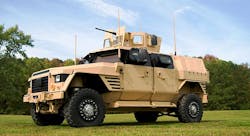Raytheon to develop UAV-killing laser weapon small enough to fit on Joint Light Tactical Vehicle
Officials of the U.S. Office of Naval Research (ONR) in Arlington, Va., awarded an $11 million contract to the Raytheon Space and Airborne Systems segment in El Segundo, Calif., to develop a vehicle-based laser device capable of defeating low-flying threats such as enemy drones, Raytheon announced this week.
The contract is part of the ONR's Ground–Based Air Defense Directed Energy On-The-Move program (G-BAD DE OTM), which seeks novel subsystems and components for a future UAV-killing laser vehicle that can fire on the move.
The U.S. Army, meanwhile, is investigating laser vehicles such as the Boeing truck-mounted High Energy Laser Technology Demonstrator (HEL TD) to defend Army troops against UAVs, rockets, artillery shells, mortars, and similar threats.
Related: Navy eyes tactical vehicle-mounted UAV-killing laser to defend Marines while on the move
The big difference with the Raytheon G-BAD contract, however, is firing on the move. The HEL TD, which has been demonstrated at White Sands Missile Range in New Mexico, is designed to move to deployed Army sites and engage targets from fixed sites. The future Marine Corps G-BAD laser weapon is envisioned to fire laser weapons while maneuvering with moving Marine Corps air-ground task forces.
The contract awarded this week calls for Raytheon to conduct a field demonstration of a humvee-mounted short-range laser weapon system with a minimum power output of 25 kilowatts, Raytheon officials say.
Raytheon's planar waveguide (PWG) technology is the key to its G-BAD approach, company officials say. Using one PWG the size and shape of a 12 inch ruler Raytheon high energy lasers generate sufficient power to effectively engage small aircraft.
While the Army HEL-TD program seeks to mount a 10-kilowatt laser weapon on a 10-ton eight-wheel truck to engage targets from a distance, the G-BAD initiative seeks to mount a short-range air-defense laser at least as strong as 25 kilowatts on a four-wheel Joint Light Tactical Vehicle (JLTV), which the Army, Marines, and Special Operations forces are developing to replace the Humvee.
Navy researchers are asking Raytheon to develop a G-BAD laser weapon that can fire at full power for as long as two minutes, followed by a 20-minute recharge to 80 percent of total capacity. The laser weapon should not weigh more than 2,500 pounds, and needs to fit in the JLTV's cargo area.
Marine Corps officials say current low-altitude air-defense systems have weaknesses against UAVs, which are becoming armed threats, and say they need something like the G-BAD concept as a new expeditionary mobile air-defense weapon.
Raytheon will develop the G-BAD laser weapon from the ground up to prevent reconnaissance, surveillance, targeting, and engagement of expeditionary forces by UAVs. Eventually Navy researchers want a JLTV-mounted 50-kilowatt laser weapon.
The G-BAD system will consist of three subsystems: a volume-surveillance radar, command and control (C2), and a high-energy laser weapon. Navy researchers envision the G-BAD laser weapon ultimately for the JLTV, but the first demonstrations most likely will be on a M1152A1 humvee.
Related: Pentagon proposes deep cuts in lasers and directed-energy weapons work in 2013 budget
For now, the G-BAD program aims to identify, develop, and mature novel key components and subsystems that not only improve Marine Corps air-defense capability, but also offer reductions in size, weight, and power consumption, and that can operate effectively on-the-move.
On this project, Raytheon laser weapons experts will look into a rugged, lightweight beam director; improved beam control; adaptive optics; an atmospheric characterization and tactical decision aid; thermal storage and management; power generation, storage, and conditioning; weapon station controls and displays; and long range optics.
Other G-BAD technologies Raytheon is being asked to develop include light tactical vehicle-mounted command, control and communications including high-quality stills and video imagery, as well as fire-control that can acquire a target with its own sensors. The system also will need a light tactical vehicle-mounted volume surveillance radar able to detect and track potential threats.
For more information contact Raytheon Space and Airborne Systems online at www.raytheon.com, or the Office of Naval Research at www.onr.navy.mil.
